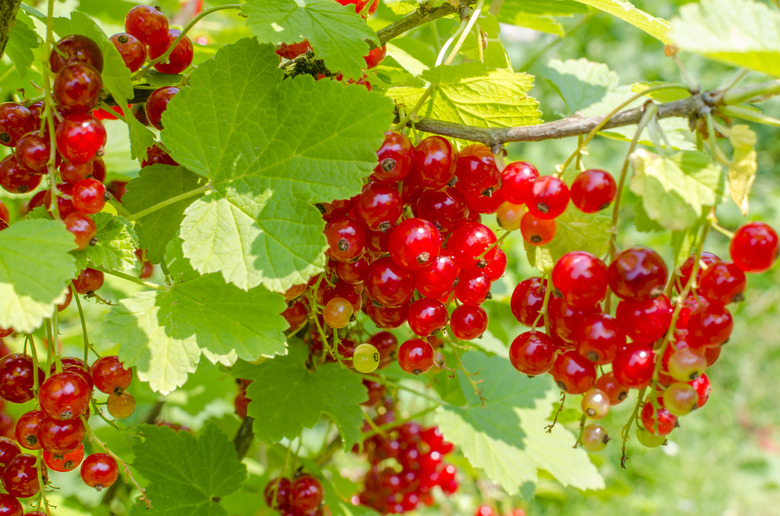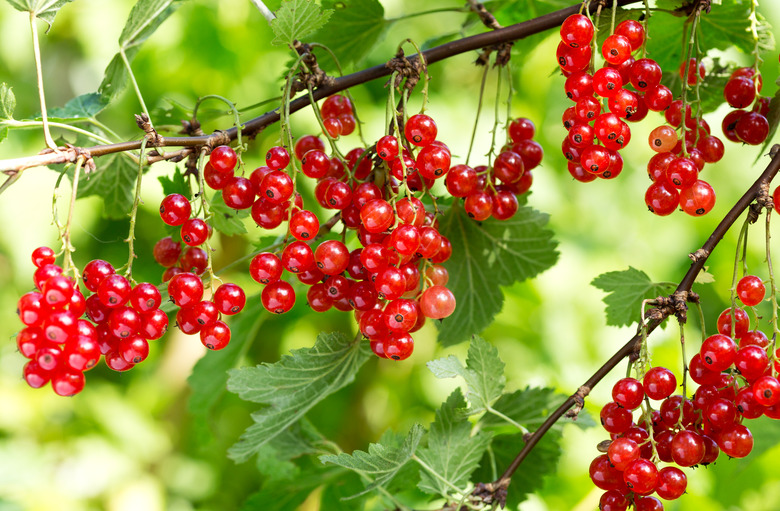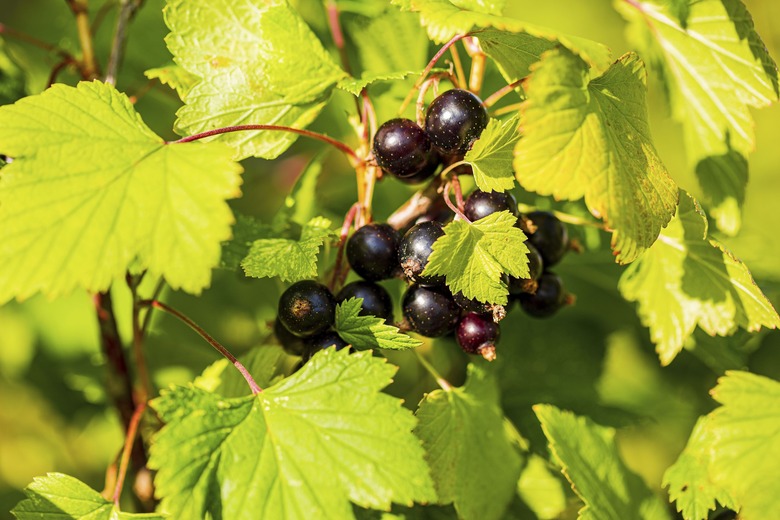How To Grow Currants
We may receive a commission on purchases made from links.
If you live in a northern climate zone and have a shaded part of your landscape to fill, a currant (Ribes spp.) bush may be just what you're looking for. Currants — those small, round, tart berries that find their way into jams, jellies and occasionally straight into the mouths of aficionados — add color to any landscape. The plant grows from 3 to 6 feet wide and tall, and black currant bushes or red currant ones will seldom dominate your other plants much less overrun them the way blackberries or raspberries will. Besides red and black currants, you can also grow white currants, and if you like how currants taste, you'll love these.
Currant bushes are deciduous, and they have thornless stems — which is nice — along with attractive flowers and leaves reminiscent of maple leaves, but the showpiece of every bush is the fruit. Currants grow in clusters and hang from the branches, and when the translucent berries catch sunlight, they look like glass replicas of themselves. Their sour taste isn't to everyone's liking, but it's there because they are chock full of vitamin C as well as potassium, phosphorous, protein and the least amount of fat of any fruit except nectarines.
Before deciding on adding a currant bush to your yard, check with a local nursery or university extension to see whether you're allowed to grow them in your area. Currants and gooseberries are restricted in some areas because they help complete the life cycle of the fungus that causes white pine blister rust, a disease that can devastate nearby pine trees and other agricultural crops. Black currants are particularly susceptible, but there are disease-resistant varieties that may be safe to plant in areas where restrictions are in force.
Best Uses for Currants
Best Uses for Currants
Although they like full sun, currants are one of the few bushes you can also plant in shade, and they can help fill the space on the north side of your house or underneath a large tree in the backyard, There are many other ways to take advantage of the dense foliage, showy fruit and moderate size of the currant plant:
- Plant it around the bases of fruit trees to create an edible landscape feature.
- Use it as a foundation plant or as a border plant for your front walkway.
- Set currant bushes on the edges of your property to provide a colorful transition to a wooded area beyond. It will attract all types of birds, and currants are said to be deer-resistant.
- Include it in your herb garden. Black currant leaves have medicinal properties, and the berries are an excellent source of vitamin C.
Bushes of the various currant varieties grow to different sizes, from 5 or 6 feet tall and wide to 12 feet. Bushes for red and white currants, such as the popular 'Red Lake' cultivar, seldom grow larger than 5 feet and are more suited for foundation planting, while black currants are better for hedges and boundaries. Chickens like all types of currants and appreciate one or two currant bushes in their foraging area.
How to Grow Currants
How to Grow Currants
- Common Name: Currants
- Botanical Name: Ribes spp.
- When to Plant: In early spring as soon as the ground is workable. If the ground doesn't freeze, plant during the late-winter dormancy period.
- USDA Zones: 3-8
- Sun Exposure: Full sun, partial shade
- Soil Type: Well-draining soil rich in organic matter. Soil pH should be between 5.5 and 7.0.
- When it's in Trouble: The currant plant is easygoing, but it will shrivel and wilt if the soil is too alkaline.
- When it's Thriving: Dense, emerald-green foliage and vibrant, well-formed berries.
Starting Currants From Seed
While the currant plant is usually grown from a plant cutting or a store-bought plant, it is possible, although troublesome, to grow it from seed. The seeds have to be stratified to make them viable by putting them between two moist layers of peat moss or a similar porous material and maintaining them at a temperature between 33 and 34 degrees in a refrigerator for three or four months.
After that, press them into a bed of peat moss, cover with a layer of soil and maintain the seeds at a temperature between 65 and 75 degrees Fahrenheit in bright, indirect light until they germinate. Transfer the seedlings into pots when they are large enough and plant them in the garden in fall or early spring.
Starting Currants From Plants
Amend clay or sandy soil with organic matter to a depth of several inches over an entire planting site (instead of the planting hole) before planting cuttings or store-bought plants. Dig the hole as deep as the rootball and twice as wide, spacing plants from 4 to 6 feet apart to promote air circulation. Because they grow larger, black currant plants should be further apart than red and white currants.
Water the roots deeply to allow the wet soil to flow around the roots and remove any air pockets in the root ball. Apply organic mulch around the base of the plant to retain moisture and discourage weeds.
When transplanting bare-root plants, you want to make sure the roots have been soaked directly for at least three to four hours before planting. Prune all stems back to 6 to 10 inches above ground level, trim off any unusually long roots and set the plant deep enough for the lowest branch to be below ground level to ensure it will grow into a bush. Backfill, tamp and water deeply.
In What Zone Do Currants Grow Best?
In What Zone Do Currants Grow Best?
Currants grow in USDA hardiness zones 3 to 8, but they prefer the cooler conditions in zones 3 to 5. Currant plants do not tolerate extreme heat and will lose their leaves when temperatures are above 85 degrees for an extended period. Currants should be planted in full sun to get the sweetest fruit, but in zones 6 to 8, it's a good idea to plant them in an area that gets protection from the afternoon sun.
When Should You Plant Currants?
When Should You Plant Currants?
Currant transplants are ready to burst into action as soon as the growing season begins, so it's best to get them in the ground as early in the spring as you can. If you live in a region in which the ground doesn't freeze over, a mid to late-winter planting is recommended, which allows the roots to get established before the growth spurt begins.
Flowering and fruiting doesn't occur until the second or third season. In the first year, prune currants by snipping an inch off the tip of each branch when the plants are dormant in winter to stimulate branch growth.
Soil, Sunlight and Water Recommendations for Currants
Soil, Sunlight and Water Recommendations for Currants
Currants aren't particularly fussy about the soil, but they perform best in rich, well-draining, slightly acidic soil. Mixing in rotted compost or manure is recommended, and after planting, add 2 to 4 inches of organic mulch. Mulching every year helps keep down the soil temperature, and a couple of tablespoons of liquid 10-10-10 fertilizer maintains plant health.
Although currants thrive in full sun, they can also be productive in partial shade. They need water throughout the growing season from spring until harvest. They may develop mildew late in the season if they don't get enough water in spring.
How to Propagate Currants
How to Propagate Currants
The currant bush is one of the easiest bushes to grow from cuttings, and you'll probably have plenty of these after a yearly maintenance pruning. To obtain a cutting for planting, choose a year-old stem and cut a 6- to 12-inch section with your secateurs just below a bud and snip off the tip just above the last bud on the branch, making a diagonal cut to ensure that rain water runs off.
Press the branch in a pot with potting soil, optionally dipping the base in rooting hormone to stimulate root growth. Keep the pot in partial shade until you transplant the bush the following spring.
How to Winterize Currants
How to Winterize Currants
Like all deciduous species, the currant bush loses its leaves and goes dormant in the winter, and no special care is needed. A little extra mulching around the base of the bush doesn't hurt, but currant roots like cold temperatures and don't need much water in the winter, so it isn't really necessary.
How to Harvest Currants
How to Harvest Currants
From late May to early July, you'll know when the currants you grow are ready by simply tasting one. Ripe currants are soft and sweet, while unripe ones are a little harder and decidedly more sour. Currants won't ripen after you cut them, so leave the ones you want to eat on the bush to ripen fully, but don't wait too long or you may lose the best ones to the birds. Unripe berries contain more pectin and are best for making jams and jellies.
Currants grow in bunches, and you usually harvest the entire bunch and pick off the individual berries one by one. Berries don't all ripen at once, and they keep for only a few days in the refrigerator, so you'll be making several trips to the bush at harvest time.
Common Pests and Other Problems for Currants
Common Pests and Other Problems for Currants
Aphids congregate on the leaves and deposit sticky honeydew, which can promote mildew. Wash them off with a strong spray of water or use an insecticidal soap. Ladybugs are natural predators.
The wormlike currant borer lays eggs on the branches, and when the larvae emerge, they bore into the canes, overwinter there and emerge in the spring. Leaves on affected canes turn yellow. Prune off the affected canes and destroy them.
Spider mites look like tiny spiders, and like spiders, they create webs between the leaves. They suck the juices out of the leaves and inject toxins, and the leaves turn dry and yellow. Treat them as you would aphids by spraying them off with water or by using a miticide.
Common Diseases for Currants
Common Diseases for Currants
Anthracnose is a fungal disease that forms spots on the leaves and inhibits fruiting. It's most common during periods of high temperatures and humidity. Prevent it by watering at the base of the plants but not the leaves, pruning plants to create space between them for good air circulation and mulching to prevent infected soil from splashing on the plants.
Septoria leaf spot usually appears in June just before the berries ripen, and it's also a fungal disease. It strikes the lower leaves first, forming spots that gradually widen and turn light inside with a brown border, and smaller spots that are the actual fungus appear within the large ones. Remove infected branches as well as all nearby weeds, which can also harbor and spread the disease. You can treat it with a commercial fungicide.
White pine blister rust does not do much damage to currant bushes other than causing yellow spots to appear on the undersides of the leaves, but it is deadly to nearby pine trees. If you see signs of this disease, avoid wetting the leaves while watering. If it's a severe infection, removal of the entire plant is recommended. Replant with a disease-resistant variety.
References
- Tenth Acre Farm: How to Grow and Use Currant Bushes
- Burpee: Learn About Currant
- Grow Veg: How to Plant and Prune Currant Bushes
- PennState Extension: Disease Descriptions for Gooseberries and Currants
- Harvest to Table: How to Plant, Grow, Prune and Harvest Currants
- University of Minnesota Extension: Growing Currants and Gooseberries in the Home Garden



